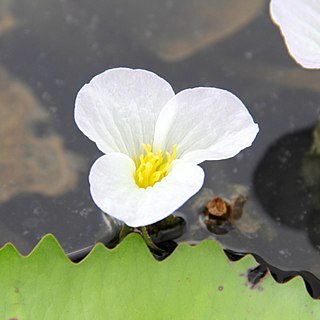Monoecious, dioecious or hermaphrodite, annual or perennial.. Stems corm-like, simple or rarely forked.. Juvenile leaves linear to obovate or spathulate.. Mature leaves petiolate; blade submerged or floating, elliptic to widely ovate, 8–17 cm. long, 5.7–20 cm. wide, acute to obtuse or rounded, cuneate to cordate or somewhat involute at base, smooth, with 2–10 prominent longitudinal veins connected by cross-veins, together with many smaller longitudinal veins; leaf-margins entire or denticulate.. Nodal scales 4–10 per leaf, ovoid to conical.. Spathe: peduncle 10–50 cm. long, 0.17–0.5 cm. wide; body of spathe submerged, sometimes slightly inflated, cylindric to ellipsoid or urceolate, 2–6-lobed at the apex, with 3–12 crisped or wavy wings or ribs.. Male flowers several per spathe, with pedicels up to 7 cm. long; ♀ and hermaphrodite flowers sessile.. Sepals narrowly triangular to ovate, 0.6–2.4 cm. long, 1.8–5.7(–9) mm. wide, subobtuse to rounded, green, the margin often hyaline.. Petals ovate to orbicular, 1.8–3 cm. long, 0.5–1 cm. wide, rounded or obcordate, white, white with yellow base, yellow, pink to purple.. Stamens 3–12; anthers 2.5–4.5 mm. long, yellowish; filaments up to 6 mm. long; staminodes filiform or 2-lobed, up to 4.8 cm. long.. Ovary of 3–10 carpels, narrowly ellipsoid, 0.7–2.2 cm. long, ± 0.7 cm. wide; perianth-tube 0.6–0.8 cm. long, styles 3–10; stigmas 6–20, up to 6 mm. long, yellowish.. Fruit ellipsoid to ovoid, rarely cylindric, 1.5–4(–5) cm. long, 1–2 cm. wide, opening by decay of the pericarp.. Seeds narrowly cylindric, 0.9–1.3 mm. long, 0.3–0.5 mm. wide, dark purple to black, with longitudinal striations.
Petiole varying greatly in length according to depth of water; leaf blade wholly submerged, varying greatly in shape and size, usually broadly ovate, ovate-elliptic, suborbicular, cordate, or sometimes lanceolate, ca. 20 × 18 cm or more, membranous. Flowers bisexual or plants occasionally dioecious-polygamous. Spathe 2.5-4 × 1.5-2.5 cm, 2-or 3-lobed at apex, with 3-6 longitudinal wings. Flowers solitary, sessile. Petals white, slightly purple, or bluish. Stamens 3-9(-12); filaments glandular hairy; anthers narrowly oblong, 3-4 mm. Ovary subglobose, with 3-9(or 10) carpels; styles 6-10, deeply 2-lobed. Fruit 2-5 × 0.8-1.8 cm. Seeds fusiform, 1-2 mm, densely hairy. Fl. and fr. Apr-Oct. 2n = 44.
A herb growing in fresh water. It develops tufts and keeps growing from year to year. The clumps are 60 cm wide. The leaves are very variable and have short or long leaf stalks according to the depth of water. The leaf blade of leaves which are under water are long and those which are floating are rounded. The leaves can be 1 m long and the blade 15-20 cm long by 15-20 cm wide. The base of the leaf is heart shaped. The leaves are green to bronze. They have prominent veins. The leafy bract around the flower has 5-10 wings. The flowers are 5-6 cm across and white with darker veins. They have 3 petals. The flowers are on the surface. The fruit are oblong and 2.5 to 4 cm long.
Perennial or annual, tufted aquatic. Leaves submerged; petiole to 50 cm long; blade elliptic to widely ovate, to 17–40 cm long, 5–25 cm wide, thin, translucent. Flowers floating or submerged, bisexual or unisexual (not in Australia), either chasmogamous and emergent or cleistogamous and submerged. Spathe 4–10-winged, 2–4 cm long, membranous, smooth or tuberculate. Sepals 1.0–1.5 (–2.4) mm long, green. Petals obovate to orbicular, to 3 cm long, usually white, often yellow at base. Stamens 9–12 (–15). Styles 3–9, each bifid almost to base. Developing fruit withdrawn below water surface as it matures. Seeds 0.9–1.1 mm long, densely hairy.
Leaves submersed; blade lanceolate to widely ovate, to 17 ´ to 20 cm, margins entire to crisped. Inflorescences 1-flowered; spathes 3--10-winged. Flowers: sepals10--15 ´ 2--9 mm; stamens 3--12; ovary 1, 3--9-carpellate. Fruits 15--40 mm. Seeds to 2000.


